Abstract
Historical and ongoing pedestrian anxiety about night crimes in alleyways is an important issue in our society. Therefore, recommended illuminance levels in pedestrian alleys have been established and security lighting meeting such illuminance levels has been installed to ensure proper brightness. However, pedestrians may still feel that such areas are too dark and want to ensure their safety through sufficient brightness, especially late at night. In this study, a smart security lighting system, which was namely the Connected Security Lighting System (CSLS), has been designed to reduce the pedestrians’ fear of crime in smart cities. The CSLS increases the brightness of security lighting by turning on additional lights to relax pedestrians’ psychological fear of crime because of the increased sense of surveillance. Such a change may also deter potential offenders. The CSLS employs various sensors and information communication technologies that are widely used in interior and outdoor smart lighting applications. It also uses a beacon device and smartphone application to effectively detect pedestrians while infrared sensors in the CSLS are activated to detect any pedestrians approaching from the opposite direction after the beacon device is initiated. The method for controlling the CSLS is described and a prototype system is presented to demonstrate the feasibility of this security lighting system in smart cities.
1. Introduction
Serious crimes, such as robbery, assault and battery, tend to occur at night [1,2] and consequently, pedestrian anxiety about crimes that occur at night is rampant in our society [3]. Alleys that are particularly vulnerable to crime occasionally have narrow paths and poor visibility [4] and security lighting in such areas often does not provide sufficient brightness (see Figure 1). Due to this issue, the recommended illuminance levels in pedestrian walkways have been established and security lighting meeting such illuminance levels has been installed to ensure proper brightness for pedestrian safety. “Security lighting is installed to help protect people and property from criminal and terroristic activities and to create a perception of a reasonably secure environment” [5], which is distinct from lighting for safety. Regardless, pedestrians may still feel that the lighting level is insufficient and want to ensure their safety through increased brightness above the recommended illuminance levels, especially late at night. Measures, such as installing additional security lighting or increasing the luminous flux of existing security lighting, can be considered to solve such problems. However, maintaining bright security lighting throughout the night consumes considerable lighting energy and results in light trespass to nearby residents, which can cause sleeping disorders and privacy infringement [6,7,8]. These issues can be solved by providing brighter light only at those locations and times in which a bright luminous environment is needed.
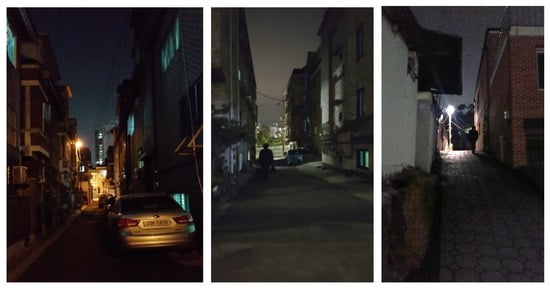
Figure 1.
Example of security lighting cases in Seoul, Korea.
Crowe [9] defined crime prevention through environmental design (CPTED) as “the proper design and effective use of the built environment can lead to a reduction in the fear and incidence of crime and an improvement in the quality of life”. CPTED effectively decreases the crime rate and promotes psychological relaxation by using the physical design of the surrounding environment [10]. Brighter security lighting is one of the methods that provides positive psychological effects to pedestrians by ensuring good visibility in the street [11,12]. Pedestrians’ fear of crime can be reduced by increasing psychological relaxation through increased brightness of security lighting [13]. The dark pedestrian spot increases the fear of the pedestrian for night time crime but the bright pedestrian spot enhances the pedestrian’s feelings of safety [14]. In addition, one of the theories for why improved street lighting may reduce crime is that “improved lighting leads to increased surveillance of potential offenders and hence to increased deterrence of potential offenders” [15]. Welsh and Farrington [16] also described data from 13 studies that demonstrated a reduction in crime after improving street lighting conditions in the United Kingdom and United States.
Smart security lighting is a recently developed system that performs various functions in smart cities. These functions depend on sensors, information technology and types of closed-circuit television (CCTV). As a CPTED method, smart security lighting can effectively prevent crimes by drawing the attention of pedestrians. The shift to LED security lighting can provide a high level of control through smart networks and reduce lighting energy consumption. Therefore, smart security lighting can be part of a very effective management method for improving the safety of pedestrians in smart cities.
In this study, a smart security lighting system with various sensors and information communication technologies has been designed as a CPTED method based on the aforementioned psychological effects [11,13,14,15,16] in order to improve the luminous environment of alleys. State-of-the-art information communication methods, such as beacon service and smartphone applications, are used for information communication between the security lighting system and pedestrians. Security lighting instantly becomes brighter when a beacon device detects a pedestrian using the corresponding smartphone application. If a beacon has detected a pedestrian, other security lightings near the pedestrian are also made sequentially brighter by infrared sensors to warn off potential criminals. Infrared sensors can detect pedestrians approaching from the opposite direction and increase the brightness of security lighting only after the beacon device is initiated. In this way, by connecting pedestrians and security lighting, the proposed system can provide positive psychological effects to pedestrians by securing good visibility and increasing the sense of surveillance in the alley. The concept and control method for this lighting system in smart cities is described and a prototype system is presented to demonstrate the feasibility of this security lighting system.
2. Related Studies
Previous studies have presented methods for controlling security lighting based on the detection of a moving body [17,18,19,20,21]. One study was conducted to develop a lighting control system in which sensors were used to turn on security lighting when pedestrians or cars were nearby in order to save energy by not using unnecessary light [17]. Other studies also proposed light control systems that used a real-time operating system (RTOS) to control security lighting based on the presence of a moving body. This method could efficiently reduce energy consumption [18,19]. A study conducted by Eveliina Juntunen et al. [20] suggested a smart lighting control system, which controls the lighting level around the pedestrian by tracking the direction and the path of the pedestrian’s motion using passive infrared sensors. Furthermore, Choi and Woo [21] proposed a method for controlling security lighting, which recognizes sounds created by a car.
Additional studies were conducted to implement smart functions, such as information communication and sensors in security lighting [22,23,24,25,26,27,28]. Elejoste et al. [22] proposed an intelligent security lighting system with high adaptability and easy installation. This system used wireless communication elements to centralize the control strategy and communication in complex scenarios. Alex and Starbel [23] proposed an energy saving system using ZigBee and sensors and they identified the current status of security lighting and analyzed its power consumption. Fabio [24] also proposed a system that could easily and efficiently manage street lights by collecting information from the street lights and transmitting it to the control station using ZigBee, sensors, LED and solar panels, which ultimately saves energy. Francisco et al. [25] suggested a streetlight control system using wireless communication and the DALI interface. This system is not only economical in terms of installation but also can be controlled and monitored at any time. In addition, Guo et al. [26] proposed a telemanagement road lighting control system to increase energy efficiency and this system automatically reacts to traffic density, weather conditions and so on. Dikel et al. [27] suggested an energy-efficient lighting control technique according to an occupancy algorithm in an interior space and they conducted a usability test of their suggested system before demonstrating the acceptability people in a test bed. Moreover, Park et al. [28] proposed a micro-distributed ESS-based smart LED streetlight system with low-cost installation and high management efficiency based on a simulation test and analysis of scenarios.
As mentioned above, several studies on the relationships between lighting and criminal psychology [11,13,14,15,16] and between lighting and crime rates [29] have been conducted. Brighter luminous environments provide good visibility and improve surveillance, which lead to decreased fear of crime and increased reluctance of potential criminals to commit crimes [30,31,32,33,34]. On the one hand, a question about the effect of an increase in illumination on pedestrian reassurance was raised by Fotios and Castleton [35] who reviewed many related studies and discussed how an investigation of reassurance might lead to an understanding of the optimum light level. Haans and de Kort [36] insisted that the level of illuminance on the street is important to make the pedestrians feel safe or not. However, light distribution should also be considered to see how it affects perceived pedestrians’ safety. Feng and Marry [37] raised concerns about enhancing the configurations of night-time lighting sources because of fiscal limitations and sustainability and light trespass issues and they suggested a methodology for street lights based on geographic information systems, spatial statistics and spatial optimization.
According to the above studies, security lighting, which is essential for pedestrian safety and crime prevention, is becoming increasingly smart. This study focuses on the concept and feasibility of a smart security lighting system based on the use of state-of-the-art information communication technologies and sensors to promote the psychological benefits to pedestrians while simultaneously minimizing additional lighting energy consumption in smart cities. The proposed system provides an instant change in the brightness of security lighting for a limited period to only those pedestrians who need more brightness to secure good visibility and increase their sense of surveillance for a relatively short time.
3. Design and Control of the Connected Security Lighting System
3.1. Concept of the Connected Security Lighting System
This study proposes a Connected Security Lighting System (CSLS), which is defined as a connected control system between pedestrians and security lighting that instantly increases brightness following pedestrian movement to ensure good visibility and to enable facial recognition of other pedestrians approaching from the opposite direction [38] (see Figure 2). This study is based on the fact that an increase in the brightness of security lighting decreases the fear of crime for pedestrians and deters potential offenders through psychological effects [11,15,16].
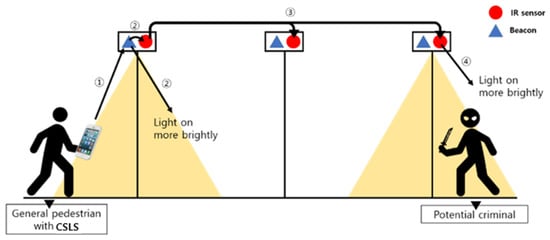
Figure 2.
Sequential process of the Connected Security Lighting System.
A clear comparison of the detection methods and anticipated effects between a general pedestrian with CSLS and a potential criminal is shown in Table 1. The sequential processes of the CSLS are shown in Figure 2. The beacon device installed in the CSLS detects the presence of pedestrians using smartphone applications and Bluetooth signals before initiating infrared sensors to change the brightness of other nearby security lights. The infrared sensor in the CSLS can detect the presence of other pedestrians who do not use the CSLS and can increase the brightness of the security lighting accordingly.

Table 1.
Comparison of detection methods and anticipated effects between a general pedestrian with CSLS and a potential criminal.
Compared with conventional security lighting, the CSLS includes additional LED chips, a beacon device [39] and an infrared sensor. The beacon device detects pedestrians and turns on an additional LED in the security lighting. Pedestrians are required to apply for this service by visiting their local government office or a related online website where they can receive a secure serial number to use the CSLS. This registration process prevents reckless use of the CSLS and increases the security level by allowing only those pedestrians who fear crime in specific alleys to access the system. The advantages of the CSLS over conventional security lighting are shown in Table 2.

Table 2.
Characteristics based on the security lighting control method.
In addition to reducing the pedestrians’ fear of crime, the CSLS can contribute to crime investigations. The pedestrian routes are recorded on the web server of the beacon service by data transmission between the CSLS and the smartphone application. If a crime occurs, this information can be used to determine the time and location of the crime.
The additional energy consumption of the CSLS cannot be estimated or generalized because it is dependent on the number, time and frequency of passing pedestrians late at night. The energy consumption of the beacon device, information communication and infrared sensor can be considered to be relatively small compared to that of security lighting itself.
3.2. Information Communication Control Method
Beacon service, which does not require a pairing process, is used as the near-distance communication protocol based on Bluetooth Low Energy (BLE) because it is impractical to pair the smartphones of all pedestrians passing through the alley with all the installed security lightings. Beacon device repeatedly transmits a single radio signal at intervals of approximately 1/10th of a second, which is made up of a combination of letters and numbers and can recognize the user and trigger an event [39]. This service is a near-distance wireless communication method based on the Bluetooth function and can identify the location of a user. The maximum transmission distance of a beacon signal is approximately 50 m (using BLE). This service, which is currently used in many commercial areas (shopping malls, coffee shops, fashion retail shops and so on), can also be classified as a low-frequency beacon or Wi-Fi beacon according to the signal transfer method.
Beacon service requires a beacon device, a beacon device Software Development Kit (SDK) for smartphone applications and a server for the beacon manager and service [40]. The beacon device periodically sends out signals (see Figure 3). After this, when a smartphone application is detected within the signal range (50 m) of the beacon device, this device sends a specific ID to the smartphone. The smartphone application that contains the beacon device SDK recognizes the ID and sends it to the server for the beacon manager and service. The server then confirms the location of the smartphone and sends the event and service information for the corresponding location to the smartphone. Thus, pedestrians can receive information while passing the beacon device with the provided smartphone application and Bluetooth function.
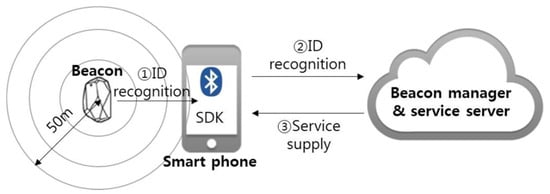
Figure 3.
Operation principle of beacon service.
3.3. Detailed Control Procedure for the Connected Security Lighting System
Figure 4 shows the procedure for the control method of the CSLS. In this figure, pedestrian A uses the CSLS smartphone application whereas pedestrian B is simply passing by on the street. This control method aims to adjust the brightness of the CSLS near the pedestrian using the beacon device and infrared sensor.
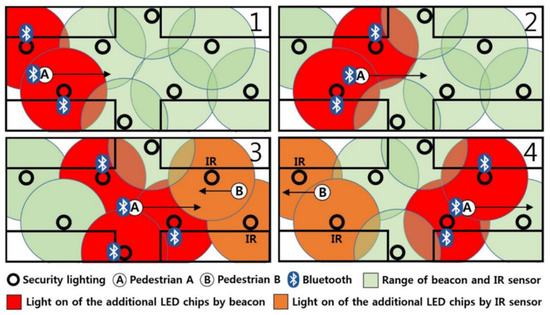
Figure 4.
Plane view of the procedure for the control method of the beacon device and infrared sensor.
Prior to using the CSLS, pedestrian A receives a secure serial number from the local government and registers this number. Once user authentication is completed, the beacon device can recognize his/her smartphone application. When pedestrian A enters the detection range of the beacon device, the beacon device recognizes the pedestrian and turns on the additional LED chips. At the same time, the beacon device initiates the infrared sensors installed in the security lighting that are part of the CSLS within a 100 m radius. This distance is generally assumed to be the range of visual stimulation or approach of the subject [41]. The infrared sensor is only initiated by the beacon device of the CSLS to prevent the additional LED chips from switching on and off unnecessarily in order to avoid wasting lighting energy. When pedestrian B enters the detection range of the initiated infrared sensor, the additional LED chips are turned on. The additional LED chips are automatically turned off after the pedestrian leaves the detection range of the beacon device.
4. Prototype of the Connected Security Lighting System
4.1. Specifications of the Connected Security Lighting System
A prototype of the CSLS is shown in Figure 5. A beacon device is attached to the exterior of the LED luminaire head and an infrared sensor is installed inside. The detection range of the beacon device is set to 5 m whereas the detection range of the infrared sensor is set to 10 m. Two channels are used to individually control the basic LED chips and the additional LED chips.
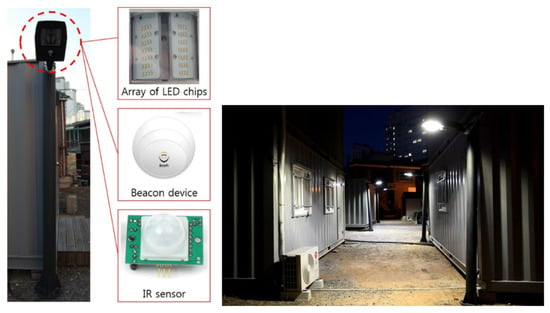
Figure 5.
Picture of the CSLS prototype.
Table 3 presents the correlated color temperature (CCT) and luminous efficacy of the LED chips that were used in four security lightings. The basic LED chips have a CCT of 4000 K, which is commonly used in conventional security lighting whereas the additional LED chips triggered by pedestrian movement have CCTs of 3000 K, 4000 K, 5000 K and 5700 K. Additional LED chips with four different CCTs are tested here to determine the most effective CCT for pedestrians to recognize a change in brightness and feel reassured. These results will be applicable to future research.

Table 3.
Specification of the LED chips.
Seven LED chips are arranged in each row, with four rows on the left and right columns. The basic LED chips are placed in the two middle rows whereas the additional LED chips are placed in the two edge rows. The basic LED chips and additional LED chips both have a total power of 50 W.
The beacon SDK required for beacon service is included in the smartphone application and a demo version has been developed. The entry screen and main screen appear sequentially when the smartphone application is initiated. A pop-up screen informs users of the status of additional LED chips after their movement.
4.2. Network Connection and Detailed Operation Scenario
Figure 6 shows the network connection and sequential communication order of the CSLS. The CSLS includes a beacon device and infrared sensor in the LED luminaire with communication tools, such as a Wi-Fi module, AP router and ZigBee. The CSLS also uses the web server of the beacon manager and service.
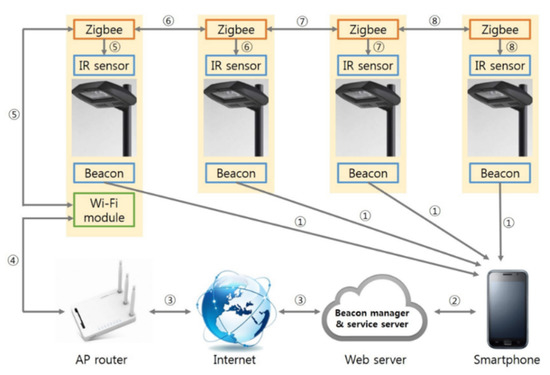
Figure 6.
Network connection and sequential communication order.
The sequential communication order of the CSLS is shown from ① to ⑧ with directional arrows in Figure 6. When a pedestrian who has the CSLS smartphone application approaches the security lighting, a wireless signal from the beacon device is transferred to his/her CSLS smartphone application. After this, the CSLS smartphone application sends the wireless data to the web server and the web server sends these data to the AP router via the internet. The AP router subsequently sends the data to the Wi-Fi module installed in the security lighting. Finally, the Wi-Fi module uses ZigBee wireless communication to initiate the infrared sensors installed in the next security lighting and sends these data to the other security lightings. When the CSLS detects a pedestrian within the detection range of the beacon device and infrared sensor, it increases the brightness from only the basic LED chips (100%) to the basic and additional LED chips combined (200%).
As shown in Figure 7, when a pedestrian who uses the CSLS smartphone application is in section A (within the detection range of the beacon devices on security lights no. 1 and 2), the additional LED chips on both no. 1 and 2 are turned on. If the pedestrian moves to the right and enters section B (within the detection range of beacon devices on no. 2 and 3), the additional LED chips of no. 3 are turned on. At that time, the pedestrian is out of the detection range of no. 1 so the additional LED chips in no. 1 are turned off after a delay period. Thus, when the pedestrian is in section B, the additional LED chips of no. 1, 2 and 3 are all turned on for a short period. After this, the additional LED chips of no. 1 are turned off after the delay period. If the pedestrian then enters section C, the additional LED chips of no. 4 are turned on, with those of no. 2 and 3 remaining on. Similarly, the additional LED chips of light no. 2 are turned off after a delay period and the additional LED chips of no. 3 and 4 are turned on when the pedestrian is in section D.

Figure 7.
Detailed operation scenario of the CSLS.
A similar operation scenario using infrared sensors instead of beacon devices is applied to the case without the CSLS smartphone application. When a pedestrian enters section D (within the detection range of the infrared sensor of no. 4), the additional LED chips of no. 4 are turned on. If the pedestrian moves to the left and enters section C (within the detection range of the infrared sensors of no. 3 and 4), the additional LED chips of no. 3 are turned on. Thereafter, the operation scenario and delay time in the beacon device control are applied to the control procedure of the CSLS.
5. Summary
This study proposes the CSLS, which implements the state-of-the-art information communication technologies and the concept of CPTED to improve the luminous environments of alleys for pedestrians in smart cities. The CSLS instantly increases the brightness of security lighting by turning on additional LED chips to provide positive psychological effects to pedestrians and deter potential criminals due to an increased sense of surveillance. However, this change occurs only at those locations and times in which a bright luminous environment is needed. This system utilizes a beacon service to recognize the pedestrian’s CSLS smartphone application. After this, the system turns on the additional LED chips of the security lighting near the pedestrian and initiates the infrared sensor in the surrounding security lighting.
An actual prototype CSLS was constructed to demonstrate the feasibility and operation logic of the system. The detailed procedure of the CSLS control and network information technology and the sequential communication order with detailed operation scenarios are described. The results show the effectiveness of the CSLS network connection and operation scenario. Although quantitative and specific verification was not performed by subjective evaluations, providing a new system concept based on pedestrians’ psychological relaxation effects in previous studies is meaningful.
The CSLS may temporally increase the illuminance value of the street environment over the recommended value when the additional LED chips are turned on. This temporary increase can intensify issues, such as sleeping disorders and privacy infringement from light trespass. Repetitively switching the additional LED chips on and off can also cause visual discomfort to residents. This lighting pollution issue should be considered for the actual installation of the CSLS. To reduce light trespass to residential areas, a fully or partially shielded design of the security lighting should be further developed.
In future studies, a quantitative and qualitative assessment of the effectiveness of the proposed system should be conducted and the effects of light trespass to nearby residents should be investigated. Studies on the CCT of the additional LED chips and the amount of additional luminous flux are also necessary to help pedestrians more effectively recognize changes in the brightness of the CSLS. Detailed questionnaire content and subjective evaluation procedures are needed to obtain these data.
Author Contributions
Conceptualization and Methodology, Y.C., H.J. and A.C.; Formal Analysis and Writing—original draft, Y.C., H.J.; Supervision, A.C.; Validation, M.S.; Writing—review and editing, Y.C.
Funding
This work was supported by the National Research Foundation of Korea (NRF) grant funded by the Korea government (MSIP) (No. 2017R1A2A1A05001170).
Conflicts of Interest
The authors declare no conflict of interest.
References
- Loukaitou, S.A.; Liggett, R.; Iseki, H. The geography of transit crime: Documentation and evaluation of crime incidence on and around the green line stations in Los Angeles. J. Plan. Educ. Res. 2002, 22, 135–151. [Google Scholar] [CrossRef]
- Nick, M.; Alison, H.; Linda, S.; Andrew, E. Using an Agent-Based Crime Simulation to Predict the Effects of Urban Regeneration on Individual Household Burglary Risk. Environ. Plan. B Plan. Des. 2013, 40, 405–426. [Google Scholar]
- Park, K.R.; Choi, I.S.; Park, S.H.; Ko, C.Y.; Kang, Y.G.; Park, H.H.; Lee, K.H. The Development of Crime Risk Assessment Tool and Its Application in South Korea (I); Korean Institute of Criminology: Seoul, Korea, 2012. [Google Scholar]
- Lee, I.H.; Jung, S.W.; Lee, J.W.; Elizabeth, M. Street crime prediction model based on the physical characteristics of a streetscape: Analysis of streets in low-rise housing areas in South Korea. Environ. Plan B Urban Anal. City Sci. 2017. [Google Scholar] [CrossRef]
- IESNA. IES G-1-16 Guideline for Security Lighting for People, Property and Critical Infrastructure; IESNA: New York, NY, USA, 2016. [Google Scholar]
- Garvey, P.M. On-premise commercial sign lighting and light pollution. LEUKOS 2005, 1, 7–18. [Google Scholar] [CrossRef]
- Saraiji, R.; Oommen, M.S. Light Pollution Index (LPI): An integrated approach to study light pollution with street lighting and façade lighting. LEUKOS 2012, 9, 127–145. [Google Scholar]
- Cellucci, L.; Burattini, C.; Drakou, D.; Franco, G.; Fabio, B.; de Andrea, L.V.; Ferdinando, S.; Iacopo, G. Urban Lighting Project for a Small Town: Comparing Citizens and Authority Benefits. Sustainability 2015, 7, 14230–14244. [Google Scholar] [CrossRef]
- Crowe, T.D. Crime Prevention through Environmental Design: Applications of Architectural Design and Space Management Concepts, 2nd ed.; Butterworth-Heinemann: Waltham, MA, USA, 2000. [Google Scholar]
- Lee, J.S.; Park, S.J.; Jung, S.H. Effect of Crime Prevention through Environmental Design (CPTED) Measures on Active Living and Fear of Crime. Sustainability 2016, 8, 872. [Google Scholar] [CrossRef]
- Kitchen, T.; Schneider, R.H. Crime Prevention and the Built Environment, 1st ed.; Routledge: New York, NY, USA, 2007. [Google Scholar]
- Kim, D.H.; Park, S.M. Improving community street lighting using CPTED: A case study of three communities in Korea. Sustain. Cities Soc. 2017, 28, 233–241. [Google Scholar] [CrossRef]
- Painter, K. The influence of street lighting improvements on crime, fear and pedestrian street use, after dark. Landsc. Urban Plan. 1996, 35, 193–201. [Google Scholar] [CrossRef]
- Nasar, J.L.; Jones, K.M. Landscapes of fear and stress. Environ. Behav. 1997, 29, 291–323. [Google Scholar] [CrossRef]
- Welsh, B.C.; Farrington, D.P. Improved Street Lighting and Crime Prevention: A Systematic Review; Swedish Council for Crime Prevention, Information and Publications: Stockholm, Sweden, 2007. [Google Scholar]
- Welsh, B.C.; Farrington, D.P. Effects of improved street lighting on crime. Campbell Syst. Rev. 2008, 13, 1–51. [Google Scholar]
- Todorović, B.M.; Samardžija, D. Road lighting energy-saving system based on wireless sensor network. Energy Effic. 2016, 10, 239–247. [Google Scholar] [CrossRef]
- In, C.G.; Lin, C.H. A Development of Multi-Sensors LED Streetlight Lighting Control System Based on RTOS. JKICS 2012, 37, 1020–1026. [Google Scholar]
- Lavric, A.; Popa, V.; Finis, I.; Simion, D. The design and implementation of an energy efficient street lighting monitoring and control system. Prz. Elektrotechniczn. 2012, 88, 312–316. [Google Scholar]
- Eveliina, J.; Esa-Matti, S.; Juho, E.; Henrika, P.; Toni, Ö. Smart and dynamic route lighting control based on movement tracking. Build. Environ. 2018, 142, 472–483. [Google Scholar]
- Choi, W.C.; Woo, C.C. A development of automotive recognition streetlight lighting control with sound recognition technology. JKAIS 2015, 16, 2135–2140. [Google Scholar]
- Elejoste, P.; Angulo, I.; Perallos, A.; Chertudi, A. An easy to deploy street light control system based on wireless communication and LED technology. Sensor 2013, 13, 6492–6523. [Google Scholar] [CrossRef] [PubMed]
- Alex, R.S.; Starbell, R.N. Energy efficient intelligent street lighting system using zigbee and sensors. Int. J. Eng. Adv. Technol. 2014, 3, 41–44. [Google Scholar]
- Fabio, L. Remote-Control System of High Efficiency and Intelligent Street Lighting Using a ZigBee Network of Devices and Sensors. IEEE Trans. Power Syst. 2013, 28, 21–28. [Google Scholar]
- Francisco, J.B.O.; Francisco, J.Q.L.; Carlos, D.M.M.; José, M.F.A.; Isabel, M.G.; Manuel, O.L. Streetlight Control System Based on Wireless Communication over DALI Protocol. Sensors 2016, 16, 597. [Google Scholar] [CrossRef]
- Guo, L.; Eloholma, M.; Halonen, L. Lighting control strategies for telemanagement road lighting control systems. LEUKOS 2013, 4, 157–171. [Google Scholar]
- Dikel, E.E.; Veitch, J.A.; Mancini, S.; Hui, H.X.; Julio, J.V. Lighting-on-Demand: Balancing Occupant Needs and Energy Savings. LEUKOS 2018, 14, 3–11. [Google Scholar] [CrossRef]
- Park, S.U.; Kang, B.K.; Choi, M.I.; Jeon, S.K.; Park, S.H. A micro-distributed ESS-based smart LED streetlight system for intelligent demand management of the micro grid. Sustain. Cities Soc. 2018, 39, 801–813. [Google Scholar] [CrossRef]
- Min, B.H.; Kim, S.H.; Do, G.H. Crime Survey and Relation to Environment Factors in High-rise Apartment Sites. JAIK 1992, 8, 65–71. [Google Scholar]
- Vrij, A.; Winkel, F.W. Characteristics of the built environment and fear of crime: A research note on interventions in unsafe locations. Deviant Behav. 1991, 12, 203–215. [Google Scholar] [CrossRef]
- Siegel, L.J. Criminology: Theories, Patterns and Typologies, 5th ed.; West: New York, NY, USA, 1995. [Google Scholar]
- Abbott, J.A.; Fried, G. Asphalt jungle: Providing parking-area security through design and common sense. Cornell Hotel Restaur. Adm. Quart. 1999, 40, 46–53. [Google Scholar] [CrossRef]
- Ishii, J.; Okuda, S.; Fukagawa, K. Research on the lighting environment in the street at night. Part 2. The effect of the lighting environment in the street on the insecurity feeling. In Proceedings of the 26th Session of the CIE, Beijing, China, 4–11 July 2007. [Google Scholar]
- Boomsma, C.; Steg, L. Feeling safe in the dark: Examining the effect of entrapment, lighting levels and gender on feelings of safety and lighting policy acceptability. Environ. Behav. 2014, 46, 193–212. [Google Scholar] [CrossRef]
- Fotios, S.; Castleton, H. Specifying Enough Light to Feel Reassured on Pedestrian Footpaths. LEUKOS 2016, 12, 235–243. [Google Scholar] [CrossRef]
- Haans, A.; Kort, Y.A.W. Light distribution in dynamic street lighting: Two experimental studies on its effects on perceived safety, prospect, concealment and escape. J. Environ. Psychol. 2012, 32, 342–352. [Google Scholar] [CrossRef]
- Feng, X.; Murray, A.T. Spatial Analytics for Enhancing Street Light Coverage of Public Spaces. LEUKOS 2018, 14, 13–23. [Google Scholar] [CrossRef]
- Choi, A.S.; Kim, I.T. Korean Patent No. 10-1586611; Korean Intellectual Property Office: Daejeon, Korea, 2016.
- Kontakt.io. Available online: https://kontakt.io/beacon-basics/what-is-a-beacon/ (accessed on 15 November 2018).
- Kwon, D.W. A Study of Dementia Patient Care Monitoring System Based on Indoor Location Using Bluetooth Beacon. J. Digit. Converg. 2016, 14, 217–225. [Google Scholar] [CrossRef]
- Park, G.S.; Lee, S.H.; Park, I.S. Interpretation of crime-prone locations through visual exposure model considered for ‘visit frequency’. JAIK 2012, 28, 111–118. [Google Scholar]
© 2019 by the authors. Licensee MDPI, Basel, Switzerland. This article is an open access article distributed under the terms and conditions of the Creative Commons Attribution (CC BY) license (http://creativecommons.org/licenses/by/4.0/).